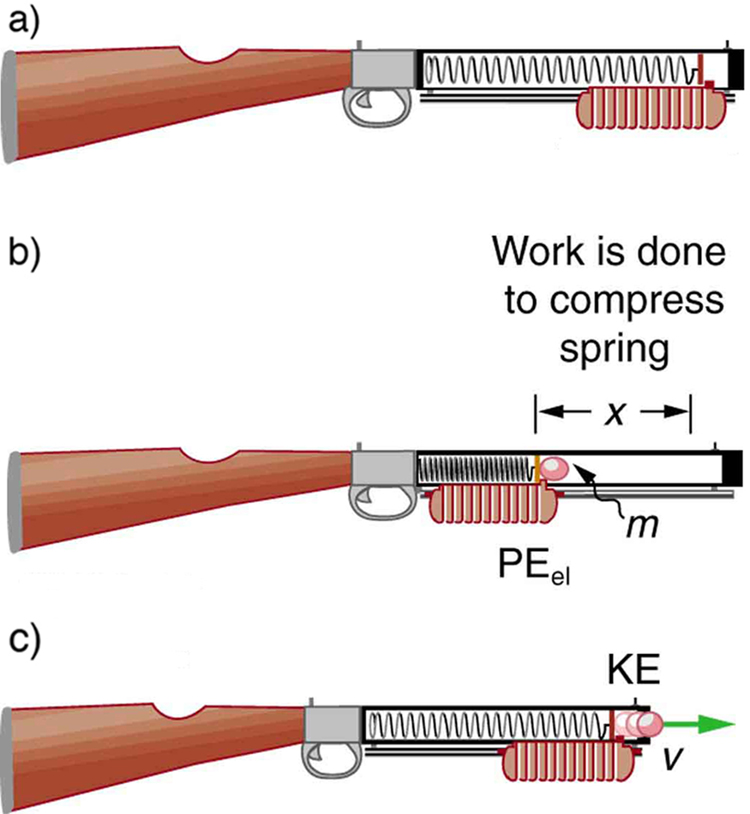| << Chapter < Page | Chapter >> Page > |

We can use a toy gun’s spring mechanism to ask and answer two simple questions: (a) How much energy is stored in the spring of a tranquilizer gun that has a force constant of 50.0 N/m and is compressed 0.150 m? (b) If you neglect friction and the mass of the spring, at what speed will a 2.00-g projectile be ejected from the gun?

Strategy for a
(a): The energy stored in the spring can be found directly from elastic potential energy equation, because and are given.
Solution for a
Entering the given values for and yields
Strategy for b
Because there is no friction, the potential energy is converted entirely into kinetic energy. The expression for kinetic energy can be solved for the projectile’s speed.
Solution for b
Discussion
(a) and (b): This projectile speed is impressive for a tranquilizer gun (more than 80 km/h). The numbers in this problem seem reasonable. The force needed to compress the spring is small enough for an adult to manage, and the energy imparted to the dart is small enough to limit the damage it might do. Yet, the speed of the dart is great enough for it to travel an acceptable distance.
Envision holding the end of a ruler with one hand and deforming it with the other. When you let go, you can see the oscillations of the ruler. In what way could you modify this simple experiment to increase the rigidity of the system?
You could hold the ruler at its midpoint so that the part of the ruler that oscillates is half as long as in the original experiment.
If you apply a deforming force on an object and let it come to equilibrium, what happened to the work you did on the system?
It was stored in the object as potential energy.
where is the restoring force, is the displacement from equilibrium or deformation, and is the force constant of the system.
Describe a system in which elastic potential energy is stored.
Fish are hung on a spring scale to determine their mass (most fishermen feel no obligation to truthfully report the mass).
(a) What is the force constant of the spring in such a scale if it the spring stretches 8.00 cm for a 10.0 kg load?
(b) What is the mass of a fish that stretches the spring 5.50 cm?
(c) How far apart are the half-kilogram marks on the scale?
(a)
(b)
(c)
It is weigh-in time for the local under-85-kg rugby team. The bathroom scale used to assess eligibility can be described by Hooke’s law and is depressed 0.75 cm by its maximum load of 120 kg. (a) What is the spring’s effective spring constant? (b) A player stands on the scales and depresses it by 0.48 cm. Is he eligible to play on this under-85 kg team?
One type of BB gun uses a spring-driven plunger to blow the BB from its barrel. (a) Calculate the force constant of its plunger’s spring if you must compress it 0.150 m to drive the 0.0500-kg plunger to a top speed of 20.0 m/s. (b) What force must be exerted to compress the spring?
(a) 889 N/m
(b) 133 N
(a) The springs of a pickup truck act like a single spring with a force constant of . By how much will the truck be depressed by its maximum load of 1000 kg?
(b) If the pickup truck has four identical springs, what is the force constant of each?
When an 80.0-kg man stands on a pogo stick, the spring is compressed 0.120 m.
(a) What is the force constant of the spring? (b) Will the spring be compressed more when he hops down the road?
(a)
(b) Yes
A spring has a length of 0.200 m when a 0.300-kg mass hangs from it, and a length of 0.750 m when a 1.95-kg mass hangs from it. (a) What is the force constant of the spring? (b) What is the unloaded length of the spring?

Notification Switch
Would you like to follow the 'College physics: physics of california' conversation and receive update notifications?